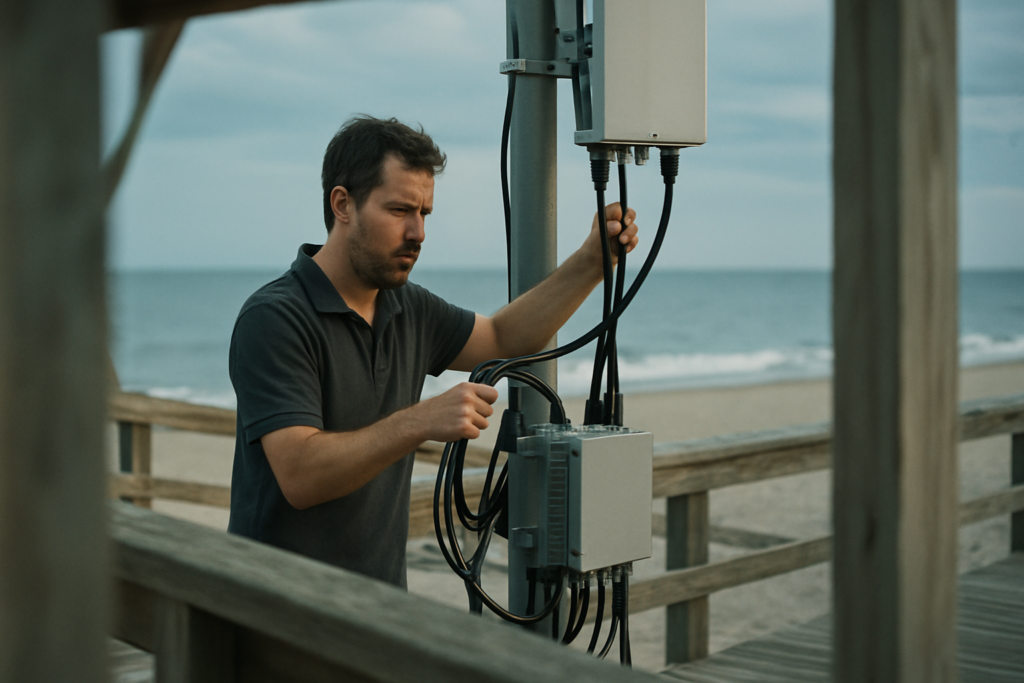Setting the Stage: Why Ethernet Still Leads
Ethernet might not be flashy, but it runs the digital world. Its reach stretches from office floors to hyperscale data centers, quietly powering everything from video calls to real time AI inference. In a landscape driven by speed and scale, Ethernet remains the baseline protocol flexible, standardized, and upgradeable.
The demand for faster, smarter networks isn’t slowing down. Data centers are scaling vertically and horizontally, spurred by the explosion of cloud computing and machine learning workloads. AI training clusters need massive bandwidth with low latency. Streaming, gaming, edge computing it all stacks pressure on the same highway: Ethernet.
That’s why traditional gigabit speeds don’t cut it anymore. Multi gig infrastructure 10G, 40G, 100G and up isn’t an optional upgrade; it’s the new survival kit. Whether you’re managing a hyperscaler backbone or rolling out a regional colo, Ethernet’s ability to hit higher speeds while keeping standards intact makes it the go to layer everyone counts on.
10G to 40G: The Early Leap
Back when networks were choking on growing workloads, 10 Gigabit Ethernet stepped in to relieve the pressure. 1G links couldn’t keep up with early stage cloud buildouts, data hungry apps, and larger virtualized environments. 10G gave businesses the bump in bandwidth they desperately needed. It was the first serious entry point for handling increased east west traffic inside data centers.
But 10G had its ceiling and hyperscale players hit it fast. That’s when 40G entered the picture. The shift wasn’t just about speed; it was about architecture. 40G aggregated four 10G lanes over parallel optics or copper, pushing throughput without changing too much of the existing ecosystem. It was a practical stepping stone, easing migration while offering better switch to switch connectivity.
In enterprise networks, 40G became the go to uplink for core refinement ideal for building out modern campus backbones or serving as a bridge between server clusters and aggregation layers. In hyperscale environments, 40G was only a pit stop. It showed up in leaf spine topologies as cloud providers scaled out, helping maximize rack density and reduce latency until better solutions emerged.
For many, 40G lit the path. It taught builders how to manage more links, more heat, and more complexity and laid the groundwork for the next generation of Ethernet evolution.
100G Becomes the New Normal
Driven by Cloud Service Providers
As cloud computing exploded in the mid 2010s, hyperscale providers like Amazon, Microsoft, and Google began to hit significant bandwidth ceilings. To support growing demands from machine learning workloads, distributed storage, and real time analytics, the move from 40G to 100G became inevitable.
High volume data movement in and out of data centers required better throughput
100G enabled more VMs and containers per server cluster
Standardization helped speed up adoption and reduce interoperability issues
Energy Efficiency and Cabling Upgrades
One of the biggest challenges with faster Ethernet isn’t just speed it’s how to keep power consumption in check. To maintain dense server and switch configurations without skyrocketing energy costs, more efficient transmission technologies were critical.
100G optics improved power per bit efficiency over legacy 40G
Fewer cables per rack reduced ventilation needs and complexity
Backward compatible cabling options eased transitions between Ethernet generations
Enter QSFP28: Small Form, Big Scalability
The introduction of QSFP28 modules marked a turning point in cost effective 100G deployment. These transceivers made it possible to scale up without overhauling entire physical infrastructures.
QSFP28 supports 4x25G lanes ideal for both breakout and aggregate topologies
Cost per port dropped significantly with industry adoption
Enabled data center operators to build spine leaf topologies with greater density and lower cost
Together, these factors positioned 100G not as a high end outlier, but as a mainstream standard for cloud scale architecture. For most enterprises and service providers, 100G rapidly became the network backbone speed of choice.
200G/400G: Meeting Hyperscale Demands

Once 100G became standard, the ceiling rose fast. Growth in AI workloads, real time analytics, and high density cloud traffic pushed infrastructure past its limits. Hyperscalers didn’t just want more bandwidth they needed it, now. The result? A rapid pivot to 200G and 400G deployments.
Technically, the leap wasn’t just about speed. NRZ (non return to zero) signaling, used in 100G and below, hit a wall in efficiency. PAM4 (4 level pulse amplitude modulation) changed the game, encoding twice the data in the same bandwidth. It comes with higher signal integrity demands and noise sensitivity, but it’s what makes 400G over fewer lanes possible and affordable.
In data center topologies, 400G is now the backbone of modern spine leaf architectures. It connects leaf switches to high capacity spine switches, reducing bottlenecks and flattening latency. For hyperscale environments, that means faster east west traffic and better horizontal scaling. In short, 400G isn’t the future; it’s the new default for anyone building at cloud scale.
One Eye on the Future: 800G to Terabit Ethernet
The future of Ethernet isn’t just faster it’s smarter, denser, and harder to cool. At the heart of this evolution are two big forces: silicon photonics and digital signal processing (DSP) innovation. Silicon photonics lets engineers put optical components directly onto chips, slashing latency and opening the door to eye watering speeds like 800G and 1.6T. Meanwhile, advanced DSP is pulling more signal out of less bandwidth while keeping error rates in check.
The IEEE is moving fast to set real time standards across this space. The 802.3df task force is already shaping the rules around 800G and 1.6Tbps Ethernet. These standards are becoming more concrete by the month, giving hardware makers and data centers something solid to build toward.
Still, scaling up isn’t just a numbers game. It comes with real headaches thermal dissipation being a big one. As transceivers push more bits through smaller form factors, heat builds up fast. Fiber management also gets tricky: denser optics demand tighter planning and cleaner deployments. And let’s not forget about power. High speed ports draw significantly more wattage, challenging rack design and PUE budgets across hyperscale environments.
Innovation is moving, but deployment won’t be turnkey. For now, prepare for high density, higher costs, and the kind of planning that pays off in megabits per dollar.
Deployment Considerations and Real World Impact
Upgrading to faster Ethernet isn’t just about raw speed it’s about matching your traffic profile to the right hardware and architecture. For some, running 10G at the edge is still fine. If you’re pushing large volumes of east west traffic in a data center, though, 100G or even 400G becomes a baseline requirement. It’s about throughput, not bragging rights.
Migrating from 10G to 400G+ isn’t a single jump. It’s a series of practical steps: evaluating existing switch ports, replacing fiber where necessary, and managing thermal loads. Breakout cables can help in phased upgrades think 4x100G before going full 400G spine. It’s also a chance to rethink L2/L3 boundaries and streamline what you’ve built up over time.
Compatibility can be a grind. QSFP standards aren’t always friendly across vendors. And sure, backward compatibility sounds nice but mismatched optics and tricky firmware can eat into your deployment schedule fast. It pays to pretest, standardize where possible, and work with vendors who play nice at the protocol level.
Cabling is another friction point. OM3 might cut it at 10G, but it’ll burn you fast at higher speeds and longer runs. Single mode fiber with proper connectors (LC, MPO) matters more than ever.
If you’re staring down a network refresh, this step by step ethernet evolution guide is a solid place to start. It walks through real world architecture examples, deployment checklists, and what to expect at every speed bump.
Summary in Speed Numbers
Ethernet has run a long race, and the milestones are more than just flashy numbers they tell the story of how networking has kept up with change. Here’s the fast breakdown:
10G: Still around in a big way. It’s the baseline for legacy networks and solid for SMBs that don’t need bleeding edge throughput. Affordable, simple, dependable.
40G: Didn’t stay at the top for long, but carved a niche in early data center aggregation. Where cost needed to stay low and bandwidth needed a bump, 40G was the interim hero.
100G: The cloud’s go to. It’s the modern spinal cord of data center infrastructure especially in spine leaf architectures. Scales well, balances power and performance, and rides on QSFP28 optics.
400G+: Built for serious scale. Hyperscalers made this the foundation of today’s core layers. With PAM4 modulation and improved DSPs, it’s all about bandwidth density and energy conscious scaling.
800G & beyond: We’re just getting to the frontier. 800G is ramping up for AI/ML heavy applications, while terabit Ethernet lurks at the edge. Think silicon photonics, extremely tight heat budgets, and architectures that haven’t fully landed yet.
Want to dig deeper into how these technologies deploy, scale, and coexist? This ethernet evolution guide breaks it all down.



